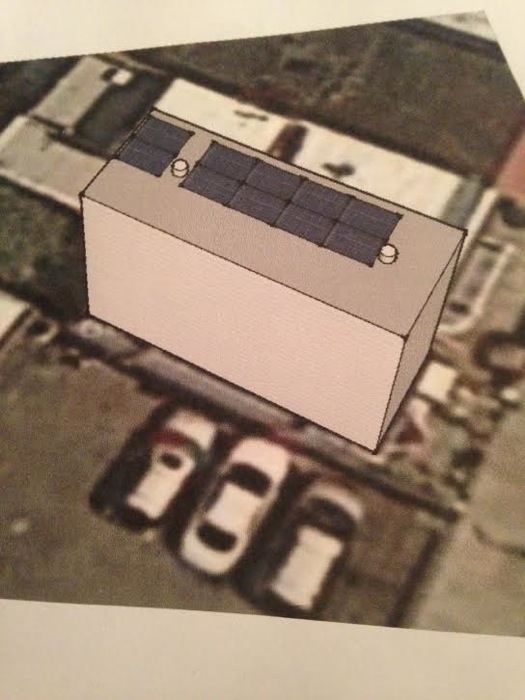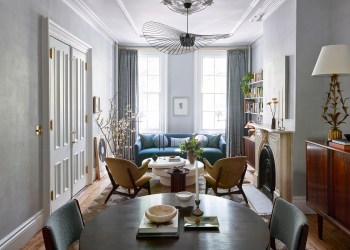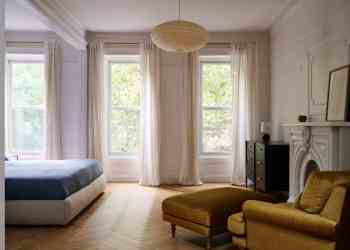Bushwick Reno: Solar Panels
Please welcome our latest renovation blogger, Pamela Capalad, who will be posting here monthly about the renovation of a Bushwick row house. Long-time readers will remember Pamela and Brian Kushner, aka Dyalekt, who together purchased a two-family row house in Bushwick for $190,000 plus $145,000 for a renovation with a 203K loan. Dyalekt is a…


Please welcome our latest renovation blogger, Pamela Capalad, who will be posting here monthly about the renovation of a Bushwick row house. Long-time readers will remember Pamela and Brian Kushner, aka Dyalekt, who together purchased a two-family row house in Bushwick for $190,000 plus $145,000 for a renovation with a 203K loan. Dyalekt is a musician and playwright and Pamela is a financial planner who also blogs at So We’re Buying a House! Her latest venture is called Brunch and Budget: The client provides the meal and Pamela provides the financial advice. We are excited to tell you that Pamela and Dyalekt have finished their renovation and now have furniture and art on the walls! Pamela will post more about that in the coming months. This week she is writing about solar panels.
Now that the house is done, on to solar panels!
Getting approved for the home equity line of credit turned out to be less painful than we thought it would be. It wasn’t the grueling back and forth of our refinance (where they grilled me about every item on my credit report and asked me to call American Express to tell them to change the fake — for security purposes — account number on the credit report to the real one so it would match up with the account statement); in fact, it was only a little more cumbersome than opening a credit card.
Even though the house was done, it wasn’t done. We had all these plans when we started that now we finally had brain space to think about and prioritize. Did we want to work on the backyard first and fully be rid of any evidence of heroin needles? Maybe install the projector and surround sound so we wouldn’t have to squint into our laptops to see which Lanister was betraying who this week? Should we throw a big paint party and have our artist friends finally put a big mural on our side wall?
Nope. Solar panels.
Of course we wanted them for environmental reasons blah blah blah, but I think part of it was we just wanted to give a big middle finger to ConEd in any small way we could. We also were nowhere near ready to think about how we wanted the backyard to look (although based on the two house plants we have, we were definitely not going to try to grow anything), so that would be next year’s big project.
Now, how to find a solar panel dealer? Is that what they’re called? Long before we knew what we were getting into with the house renovations and we were still idealistic and carefree, we had actually done a ton of research on solar panels (along with dreaming about 100 percent recycled glass countertops). We decided for sure we weren’t into leasing them if we didn’t have to, so we could catch all these crazy tax credits we were reading about.
Brian had randomly sent me some recommendations from homeadvisor.com months ago that I still had sitting in my inbox so I emailed a couple of them and picked the first one who got back to us. The owner and I had a pleasant email exchange and then he sent one of his sales reps to me. We set up an appointment for the rep to come to our house and scope it out.
He comes over in the evening and compliments our door and the dog stops barking and starts clawing on him for a pet and a scratch so we let him in. It’s still the winter/spring transition weather so it’s a bit nippy outside.
He pulls out his folder and hands us an info packet. He has Google Earthed our rooftop and printed it out with hypothetical solar panels outlines on top (pictured above). Cool. He thinks we can fit about 10, depending on how obtrusive the roof hatch is. Ten solar panels would cover about $90 to $100 of our electric bill, which, in his handy spreadsheet that factors in upfront costs and tax credits, means we will break even in about five years.
What happens if we make more energy than we use that month? I ask.
Well that’s when your meter starts to go backwards and you’re credited that amount on your next electric bill.
Also cool.
I look at the bottom line number. We look at each other. We can do that. That’s what we got the line of credit for, after all.
Before I could even ask, the rep mentions that they do offer a zero interest bridge loan between now and when we would receive the tax credits when we filed our returns.
Oh, cool.
Okay, let’s do this. What are the next steps?
He tells us we will need to schedule an appointment to have the architect come and take a look at the roof. He will come back with a final quote and a contract for us to sign. They will file all the permits with the DOB (yay!).
Awesome, how long does this all take?
About three to four months, he says.
Um what? It takes that long to put in solar panels?
He laughs knowingly. No, that part only takes three to four days. It takes a while to get this approved by the DOB and ConEd.
We now also laugh knowingly.
If there’s anyone who knows about how long it takes to get through the DOB, it’s definitely us, Brian says.
In a few days, the architect comes, and by the next week, the rep is back with the contracts and some news.
They’re going to have to install some kind of brace to hold up the panels that they weren’t anticipating, he tells us.
How much more is that going to cost?
The rep takes a breath. $2,500…
Oh.
Brian and I look at each other. We really want them, but can we handle another $2,500? I ask the rep if we can take a look at our budget and think about it.
And you’re sure that’s all that needs to be done? Otherwise, the panels usually just sit right on top of the roof?
He nods.
We are still quiet.
Here’s what I can do, the rep starts. Would it make it easier for you guys if we threw in another $2,500 in the bridge loan? He does not want to leave today without a sale from eager clients.
Well… That would give us more time to save up the extra money. We look at each other again. Should we do it?
Okay, let’s do it.
Paperwork is signed, $1,000 deposit is made, and now it’s a waiting game until the DOB and ConEd decide to play nice. This is back in April.
There have been a few additional visits from the architect since then. He wants to see where he can put the converter box (the thing that turns the solar energy into electricity, I think) and is pretty sure he can squeeze it into a small space right next to the ConEd meters in the basement. Other than that, we’ve been cc’d on all the emails to and from ConEd and it’s been pretty radio silent (except for us excitedly telling everyone we can get our hands on that we’re getting solar panels, of course).
The contract gives the solar firm until August to finally get the panels installed. Cautiously optimistic. It’s now the beginning of July and we are still waiting and wondering if the DOB is going to live up to its expectations of taking forever to get anything done.
Solar panels, here we come… Eventually.
A Two-Family in Brooklyn for Under $200,000? [Brownstoner]
Bushwick Couple Details Rehab on the Cheap [Brownstoner]









Do you mind sharing what this is costing (capital cost, DOB/ConEd costs, finance costs, tax credits)? You seem quite upfront about the building and other costs… thanks.
Hi! Feel free to email me at pam@brunchandbudget.com and I will happily share the costs with you. Don’t really feel comfortable sharing the numbers in a public post because it’s going to be money coming directly out of our bank account (all the other numbers I’ve shared before has been money held by the mortgage lender).
We definitely considered leasing, but we wanted to get the tax breaks that would normally go to the leasing company. The tax breaks cut the cost by more than half. Also, after 7 years, we would break even and all the electric bill savings would be profit from there, vs continuing to have to pay the solar leasing company. So since we had the credit line, we went for purchasing them. The solar company we went with also has as 20 year performance guarantee that it won’t drop below 87% of what it was originally performing at.
Hi! We used Seabright Solar – you can email Brian Kelly – brian@seabrightsolar.com if you want to start asking specific questions about your house. They’ve been pros throughout the whole process – just not having to deal with the DOB directly has been worth working with them.
I totally agree with you that it feels intimidating, especially when you’re just trying to sort through articles online. The reason we ended up deciding to purchase instead of lease them is because we wanted the tax break and because we got approved for a HELOC.
Our roof is pretty small, so we could only fit enough panels to cover our unit’s electric bill, but if you have the space, you can put more solar panels and I’m pretty sure the savings would be passed along to both units. Not sure how the set up would be since we didn’t go into that conversation.
Let me know if you have any other questions and good luck!